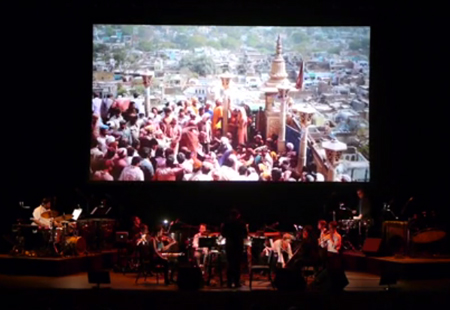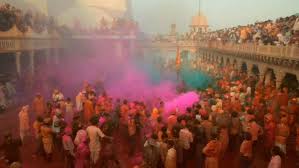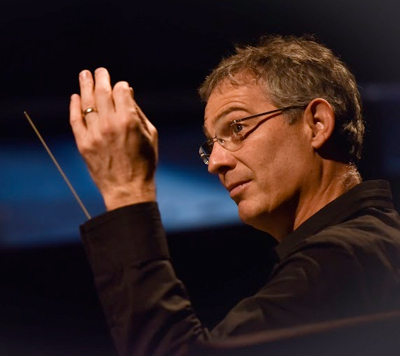by Daniel Hathaway

Iyer’s score to Bhargava’s film was premiered by ICE in 2013 to celebrate the centenary of Stravinsky’s famous work. The composer and director sought to respond to that representation of spring in pagan Russia with a new work that would point up “the significance of myth in earthly life as a living heritage.” They settled on the Hindu festival of Holi, a cathartic celebration when, as the program notes read, “everyone becomes Krishna and Radha (or fondly Radhe): all throw color and get color thrown at them. A pulsing desire to unite with the goddess sends a city into a feverish state of spinning and yearning. Everyone enters a state of uninhibited, ecstatic freedom that remains hidden for the rest of the year.”
The most colorful visuals in the dazzlingly colorful film — shot in the region around Mathura, the mythical home of Krishna — involve revelers being coated and doused with colored powder or liquids in hues that seem to have few analogues in nature. There are also scary-looking episodes where men taunt each other, and women beat a man with long sticks (ceremonial shields are provided). Later, a huge, purging bonfire lights up the riotous celebration. Occasionally, Bhargava relieves the frenzy of the crowd scenes by cutting away to semi-erotic, Bollywood-style scenes between Radha and Krishna.

Beginning with an exotic cloud of notes from Iyer at the piano, the score unfolds in dramatic fashion on a cinematic scale, suggesting but not quoting any authentic Hindu music. It surges when the streets are full of madding crowds of powdered people and ebbs into more intimate textures when Radha and Krishna are intertwining fingers and limbs.
Truth be told, the film is so visually riveting that Iyer’s music retreated into the background of consciousness, at least for those of us who find it difficult to look and listen with equal attention. Would the score stand on its own?

At the beginning of the evening, and without any visual competition, Colnot’s chamber arrangement of Rite of Spring cast ICE’s amazing musical capabilities in sharp relief. One player each on flute, clarinet (and bass clarinet), bassoon (and contrabassoon), trumpet, violin, viola, cello, bass, timpani, and piano — plus three percussionists — meant that textures were completely exposed. Players had nowhere to hide, and they didn’t need to.
Like the famous reductions for a dozen players Arnold Schoenberg and his Viennese colleagues made of mammoth orchestral works, Colnot’s version left nothing essential out of the score, and should prove useful to dance companies on a budget.
Weiss conducted a thrilling performance distinguished by wonderful individual playing and tight ensemble. Another 80 performers would have added depth, but no more excitement. It was intriguing to watch how involved some of the ICE players got with their parts. Violinist Jennifer Curtis and violist Kyle Armbrust were jiving and head-banging at times, and flutist Alice Teyssier’s face lit up when her colleagues tossed off a particularly satisfying riff — like Rebekah Heller’s haunting bassoon solo right at the beginning..
Published on ClevelandClassical.com October 25, 2016.
Click here for a printable copy of this article



